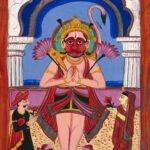Bhagavad Gita

Bhagavad Gita is an ancient Indian text that is vital to Hindu tradition, literature, and philosophy. This Bhagavad Gita course is an engaging and informative learning experience, brought to you remotely by OCHS online. Within this course, you will study the main themes of Krishna’s teachings and the principles, ideas, and theories within the 18 chapters, or 700 verses, of Bhagavad Gita.
During this course, students will dissect and interpret the Gita chapter-by-chapter in order to understand the main themes it pursues and identify the significance of this famous scripture. Each session will review different verses and chapters, clarify Sanskrit terms, and look at traditional commentaries on the Gita.
An English translation of the Gita is provided throughout the Bhagavad Gita course so that students can participate in discussions and analyses of the selected verses. This encourages students to reflect on the contemporary significance of these teachings and their influence on the modern world and Hindu culture.
To enroll on this Bhagavad Gita course, or to learn more about the course, keep reading. If you would like to see related course offerings from OCHS online, click here.
Start Date: 18 January 2026
Course Duration: Seven Weeks
153 pages
On-Demand Video
The main video component of your course. On-demand means you can watch at the time that suits you.
5hr 14 min
Community Discussions
These free Zoom sessions are not part of your main course materials. They are led by OCHS-affiliated scholars and open to students enrolled in any course.
Explore other areas of Hindu studies! Meet tutors and students from other courses!
Monday, 26 January, 12noon
Tuesday, 3 February, 2pm
Thursday, 12 February, 3pm
Saturday, 21 February, 5pm
Sunday, 1 March, 6pm
These are all UK times. Recordings are available for any sessions you miss
We will look for the key themes of the Bhagavad Gita. From this we will establish the main ideas presented in each chapter of the Gita.
What is the Bhagavad Gita?
The Bhagavad Gita appears as the sixth book of the Hindu epic, the Mahabharata – just prior to the eighteen-day battle of Kurukshetra. The hopes of the Pandava faction rest largely on the martial prowess of Arjuna. But, at the start of the Gita, we find Arjuna unwilling to wage war against his own family members. At this point Krishna begins to offer instruction to Arjuna. Initially, Krishna aims to persuade Arjuna that waging war is not necessarily wrong. However, the text goes far beyond this initial aim. It develops into a full exposition of belief and practice that has had an immeasurable influence on Hindu thought and practice.
What we will Study

The course consists of seven sessions delivered on a weekly basis.
In this course we consider the Bhagavad Gita chapter by chapter. We establish the main themes it pursues and identify the significance of this famous scripture.
For each session we provide an English translation of the chapters under consideration and discuss their significance. We clarify Sanskrit terms and look at traditional commentaries on the Gita, particularly those of Shankaracharya, Ramanujacharya, and Madhvacharya.
We will also reflect on the relevance of the Gita to the modern world.
Our course is divided into seven areas of study. Each session looks at the role of the Bhagavad Gita within the Mahabharata, its status within the Hindu tradition, and the views of contemporary scholars. The sessions are based on a progressive reading of the text, taking each chapter in turn.

Session One: Introduction to the Bhagavad Gita
In this first session we will consider the position of the Bhagavad Gita within the Mahabharata and its status within the Hindu tradition. We look briefly at the views of contemporary scholars. We will then read through the first chapter and consider Arjuna’s refusal to fight, which prompts Krishna to begin his teaching.
Session Two: Karma Yoga
In this session we will read through Chapter 2 and consider Krishna’s initial responses to Arjuna’s objections. We then concentrate on the idea of a Karma Yoga, which Krishna offers as a direct response to Arjuna’s fear of sin. Karma Yoga shows how a person can fulfil social obligations while trying to attain the highest spiritual goals. We will continue to look at Karma Yoga in Chapter 3 where it is specifically explained.
Session Three: Karma Yoga and Dhyana Yoga
Krishna continues his discussion of Karma Yoga in Chapter 4 and 5. He then moves on to an explanation of dhyana or meditation in the sixth chapter. This meditational yoga leads to direct perception of the inner self, the atman (or soul). This realisation leads to liberation from the cycle of rebirth.
Session Four: The Way of Bhakti
The final verse of Chapter 6 marks a dramatic turn in Krishna’s teaching as he introduces the idea of a Supreme Deity. This Supreme Deity creates and controls the world and delivers those who are devoted to him. This is another central idea in Hinduism and it is here that we find one of its clearest expositions. In Chapters, 7, 8, and 9 of the Bhagavad Gita we consider monotheism and devotion to God as a spiritual path.
Session Five: Revelation of the Divine Nature

We come to the middle chapters of the Bhagavad Gita. Here, Krishna not only teaches Arjuna about the nature of the Supreme Deity but reveals himself to be that Deity. Responding to Arjuna’s prayer he reveals his divine identity as that which is all things and pervades the entire creation. We will read through Chapters 10, 11, and 12 and consider the revelation of Krishna’s Vishva Rupa (universal form) and the concluding teachings on the way of bhakti (devotion).
Session Six: A Variety of Topics
In this session we will read through Chapters 13, 14, 15, and 16. After the great revelation of the divine in Chapter 11 and the emphasis placed on devotion to God, the Bhagavad Gita now covers topics that serve to reinforce the teachings that have gone before. A theme running through these later chapters is the emphasis on Samkhya ideas. In this session we consider the ways in which Krishna employs concepts derived from the Samkhya system.
Session Seven: Analysis based on the Gunas and Conclusion
We conclude our reading of the Bhagavad Gita by considering Chapters 17 and 18. Here again we find many ideas, including an exploration of the way the three gunas (sattva, rajas and tamas) can be identified within this world. The Bhagavad Gita ends its teachings by revisiting the main ideas it has presented earlier, finally concluding with a further emphasis on the importance of devotion and the power of divine grace in saving the devotee from rebirth.
Associated Courses
Your Tutor

Dr Nick Sutton
Nick is the Director – and the heart and soul – of the OCHS Continuing Education Department. He is a dedicated teacher with decades of experience in making sometimes-confusing traditions relevant. He has created over a dozen online courses and is working on many more. He has written translations and commentary on Bhagavad Gītā and the Yoga Sūtra. Nick received his Phd from Lancaster University (1995). His thesis was on the religious teachings of the Mahabharata.





